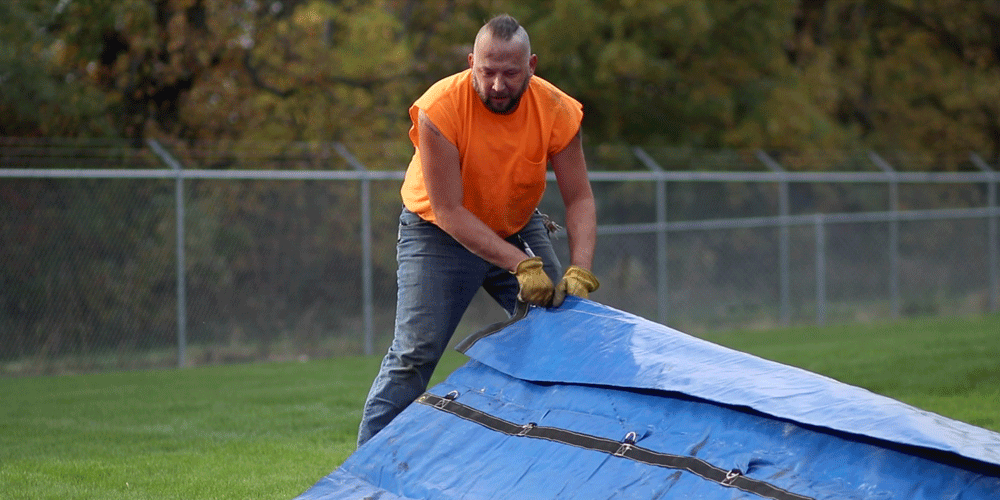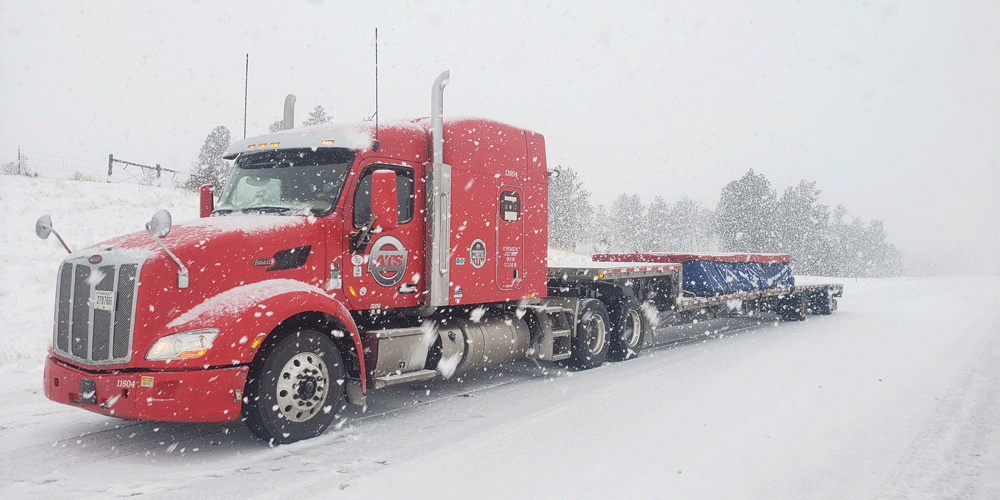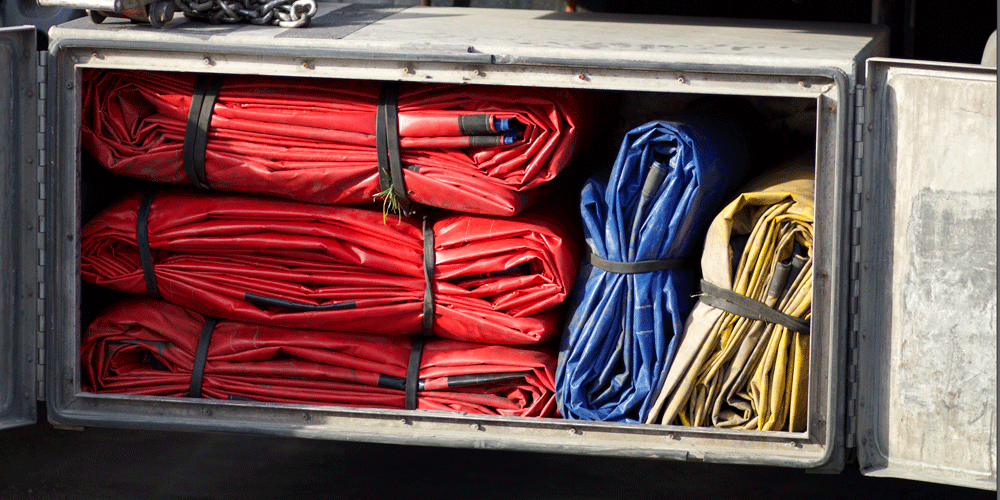 Tarping a flatbed load isn't as simple as tossing a tarp over your load, throwing some bungees on it and calling it good. Tarping is a tough job. Tarps are awkward and heavy and you have to use them when it’s freezing outside or stifling. Tarping can also be a dangerous job. Not only do you have to get into awkward positions to carry the tarp to the top of the load, but you may have to crawl on top of the load itself. Add any amount of wind to the equation and it gets extremely dangerous. The tarp acts as a sail in the wind and it can take you for a ride. Drivers tarping their loads are highly prone to injuries, whether because they fall off the load or strain their back or shoulders.
Tarping a flatbed load isn't as simple as tossing a tarp over your load, throwing some bungees on it and calling it good. Tarping is a tough job. Tarps are awkward and heavy and you have to use them when it’s freezing outside or stifling. Tarping can also be a dangerous job. Not only do you have to get into awkward positions to carry the tarp to the top of the load, but you may have to crawl on top of the load itself. Add any amount of wind to the equation and it gets extremely dangerous. The tarp acts as a sail in the wind and it can take you for a ride. Drivers tarping their loads are highly prone to injuries, whether because they fall off the load or strain their back or shoulders.
Unfortunately, tarping is unavoidable. So as a flatbed driver, you need to know how you can keep yourself safe — no matter what type of load you have to tarp.
As the safety securement specialist here at Anderson Trucking Service (ATS), I take drivers through securement training. Part of securement training includes teaching new truck drivers how to tarp their loads safely and properly.
In this article, you’ll learn:
- Why it’s important to tarp loads
- What kinds of tarps you can use
- How to tarp any load successfully
When you’re finished reading, you’ll feel confident in your ability to tarp any load you may be hauling.
Why Do We Tarp?
The reason we tarp is simple: Tarping adds additional protection to the freight against road grime, temperature and moisture (like rain, sleet or snow).
Tarping is seen more often in the winter because shippers don’t want the salt from the road on their loads.
 Types of Flatbed Tarps
Types of Flatbed Tarps
Tarps come in all different shapes and sizes. While there are standard, predefined sizes, you may decide to order custom-size tarps for specialized loads that you may haul frequently.
You can also choose various thicknesses, measured in mils. The thicker the tarp, the stronger and heavier it will be. It’ll also be more expensive. On the other hand, a thin tarp might be lighter and more affordable, but not last quite as long.
There’s a balance between choosing tarps that are best for your purpose and ones that will stand the test of time without costing you a fortune. If you’re an owner-operator or lease driver, you’ll have to purchase your tarps. If you’re a company driver, most companies will provide them for you.
Tarps are often rolled up and carried on the front end of the trailer or placed on the catwalk behind the headache rack. Some drivers keep them in a tarp tray.
There are several different types of tarps you may have to use depending upon the load you’re tarping.
Smoke Tarps
Smoke tarps are smaller tarps. They’re named this because they were traditionally used to cover the front of a load and protect it from the smoke coming off the truck. Trucks don’t smoke anymore, but the term stuck.
Because they’re smaller than other tarps, they’re good for smaller loads.
Lumber Tarps
Lumber tarps were named so because they used to be used specifically for lumber loads to protect them from the elements. However, they can be used for bulky, high rising loads.
Steel Tarps
Steel tarps are rectangular tarps that are used for steel loads. They’re heavy-duty, so they’re often a lot heavier than other tarps.
General Purpose Drop Tarps
Most drivers do just fine with general purpose drop tarps. For instance, the most common tarp we use at ATS is 20 feet by 26 feet. These tarps can be used for nearly every load you’ll haul. An irregular-sized load might work better with a uniquely shaped tarp, but a general purpose tarp will typically do the job.
How to Tarp Your Flatbed Loads: 4 Basics Steps
Following these steps is important not only for your safety but also to ensure you properly tarp your loads. If you don’t properly tarp your loads, the tarp can start blowing as you drive down the road. When this happens, you’re either damaging the tarp or the freight — both of which are costly and have the potential to cause a serious accident.
Following these easy steps, you’ll be able to tarp any load you may encounter on the road.
1. Secure the Load
Some drivers may prefer to secure their load after they’ve tarped and some secure and then tarp. There’s no right or wrong way to do it, but it’s generally easier to secure your loads first. If you wait to secure your loads after you’ve tarped, you won’t be able to see where the securement points are. When you tarp first, you lose sight of what’s below.
These tips will help you secure your loads.
2. Select Your Tarp(s)
Once you see what kind of freight you’re hauling, you’ll have a good understanding of which tarps are best to use and how many tarps you’ll need.
Depending on the type of freight you’re hauling, it’s not uncommon to have to use multiple tarps. It can be tough to use only a single tarp in the general freight world, so it’s likely you’ll have to use multiple tarps if you’re hauling over-dimensional loads on step-deck trailers.
3. Start Unrolling Your Tarp at the Back of the Load
Start at the back of the load and work your way to the front, unrolling it as you go. You may need to get on top of the load to do this effectively.
This is where a ladder comes in handy. It’s an absolute must-have tool to make the job both easier and safer. A multi-position ladder is your best option because it moves into multiple configurations and places you exactly where you need to go on your freight.
Depending on your freight, you may have to get creative with how many tarps you use and how you place them. For instance, if you have especially tall freight, you may need a tarp on each side and then one in the middle to cover the gap.
You should always ensure that when you lay your tarp down at the back of the load and overlay it with another that the end of the flap faces the back of the load. That way, the wind will pass right over it. If you leave the flap end of the tarp flat facing toward the front of the load, the wind will fill the space and create a balloon. This is also why it’s best to start tarping at the back of the load.
If you have excess tarp, tuck it underneath the tarp. Flaps or folds should be folded rearward so water and wind can roll right past.
4. Secure the Tarps
Once you’ve successfully placed your tarp(s), work your way around the load to secure the tarp(s) to the trailer. Drivers use a variety of securements to ensure their tarps stay put, but the most common securements are bungee cords.
Connect the bungee cords from the D-ring on the trailer to the D-ring on the tarp. Bungee cords come in all different sizes, so you may use different lengths or a combination of lengths to cover the distance.
Some drivers may also use rope and stitch the tarp seams together like a shoelace or they’ll use rubber rope the same way. You may use a combination of securements.
Some drivers also prefer to use heavy-duty tarp clips. The clips are inexpensive and ensure your tarps aren’t flying around as you drive. They can help prevent your tarps from puffing up in the wind — especially if you have a uniquely-shaped load.
It’s helpful to think of tarping your loads like wrapping a present. The tighter and cleaner the folds, the better it looks and the less likely it’ll be flying in the wind.
 Safety Tips for Flatbed Tarping
Safety Tips for Flatbed Tarping
Tarping is difficult and can be dangerous. These tips promote safety and success.
Ask for Help
Tarping is difficult. Ask for help from the shipper. They may not be able to help you, but it doesn’t hurt to ask.
Tarps are anywhere from 50 to 100 plus pounds. Carrying that as you walk up a ladder is awkward at best. If they can help you move the tarp on top of the load at the very least, it’ll be a big help to you.
Carry the Right Tools
Make sure you have the right tools when you’re tarping. A ladder is the number one tool. It’ll make your job easier and safer. You should never be jumping up and down off loads. You’re more likely to get injured.
You also need to make sure you’re wearing the proper gear. Most drivers wear gloves, but it should go without saying that you should wear the appropriate footwear. Open shoes are a no-go.
Remember that you’ll be tarping in all sorts of weather conditions. That means you might be tarping in below zero temperatures or humidity and temperatures above 100 degrees. Be sure you have appropriate clothing to keep you comfortable in all temperatures.
It’s also important to note that, depending on how cold it is, your tarps may become extremely rigid. You might have to wait to get to warmer weather to roll up your tarps.
Crawl, Don’t Walk
Avoid time on top of the load. It can be incredibly dangerous to be on top of a load. If you absolutely must go on top of your freight, crawl.
If you happen to come across a soft spot on the load, crawling is more stable than walking and you’re less likely to fall and injure yourself.
Stay Out of the Wind
If it’s extremely windy, don’t tarp. It’s better off to wait until the wind calms down. Sometimes that might be the next day. Tarps act like sails in the wind. If the wind takes a tarp, it’ll take you along with it. Drivers can get seriously injured if this happens.
If your tarp does get caught by the wind, let go. You’re not going to be able to hold onto it and trying to hold on only puts you in danger.
If you can tarp in an area out of the wind, take advantage of it.
Group Similar Sized Equipment Together
If you have multiple pieces of equipment on one load, try to arrange them by height. It’s better to group taller equipment together rather than grouping equipment of different sizes together. Height differences like that can create gaps that will make it easier for the wind to enter.
Pad Your Freight
Padding gets missed a lot. If the freight you’re tarping has sharp edges or corners, it’ll destroy your tarps. And tarps can cost hundreds of dollars.
Place material like furniture blankets or carpet squares on the freight to protect your tarp. You can go to a carpet or furniture score for carpet scraps.
Advance Your Flatbed Career
As you gain more experience tarping, you’ll discover tips and tricks that’ll help you. Every driver develops their own style and finds what works best for them.
The most important thing is that you’re always following safety best practices.